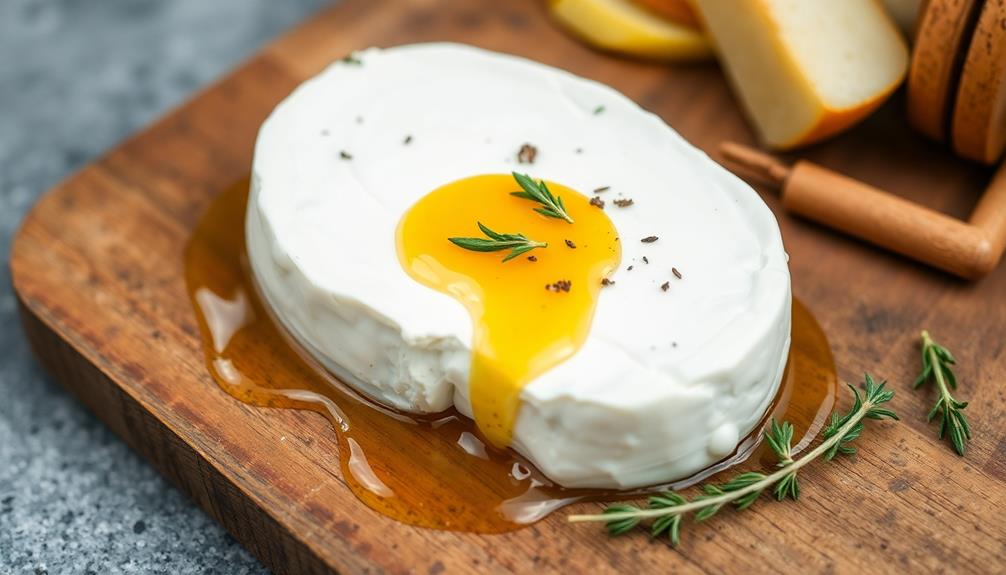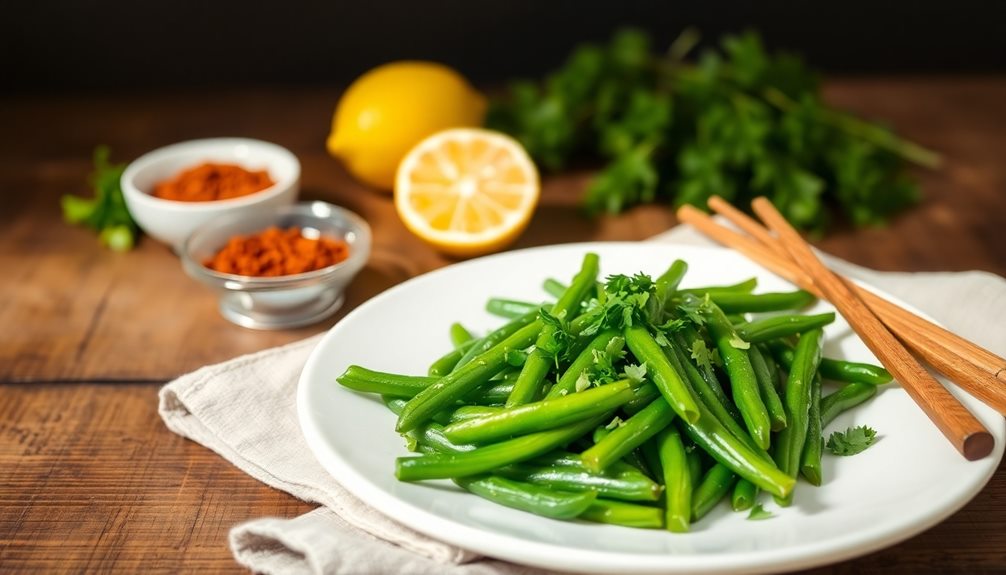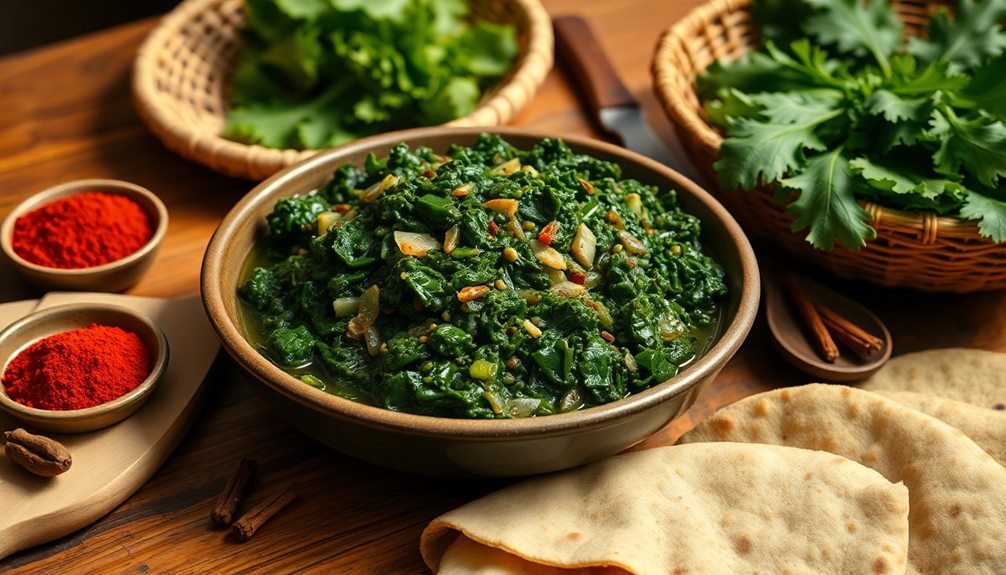Ayib, a cherished fresh cheese from Africa, has a rich history spanning centuries. It's made by curdling fresh cow's milk and straining the curds from the whey. This soft, crumbly cheese is a staple in Ethiopian cuisine, enjoyed as a side dish or ingredient in various recipes. You can get creative with ayib, molding it into fun shapes and experimenting with herbs and spices to create unique flavors. And don't waste the leftover whey – it's great for soups, baking, and even protein drinks. Ready to dive deeper into the world of this beloved African cheese?
Key Takeaways
- Ayib is a traditional fresh cheese with a rich history in various parts of Africa, often produced by nomadic herders using abundant livestock milk.
- The basic recipe for ayib involves curdling fresh cow's milk and straining the curds from whey, resulting in a soft, crumbly texture.
- Ayib is versatile, serving as a side dish or an ingredient in diverse traditional African cuisines, and can be molded into creative shapes for presentation.
- Experimenting with new flavor combinations using herbs, spices, and other ingredients can enhance the taste profile of ayib and expand culinary creativity.
- Mastery in ayib preparation comes with practice, and leftover whey can be utilized in various ways to minimize waste and maximize resources.
History
Ayib, a fresh cheese common in various parts of Africa, has a rich history dating back centuries.
It's believed that the earliest forms of this soft, creamy cheese were produced by nomadic herders, who used the abundant milk from their livestock to create a simple yet delicious dairy product. Over time, the preparation techniques and recipes for ayib evolved, with different regions and cultures putting their own unique spin on this traditional food.
Today, ayib remains an integral part of many African cuisines, with each country and community having its own distinct version. From the crumbly, slightly tangy ayib of Ethiopia to the smooth, creamy variety found in Eritrea, this fresh cheese continues to captivate taste buds and connect people to their cultural heritage. In addition to being enjoyed on its own, ayib is often incorporated into traditional dishes such as kitfo, a raw minced meat dish from Ethiopia, or mixed into sauces and stews. One popular way to enjoy ayib is in the Ethiopian fish tibs recipe, where the crumbly cheese is used to add a rich, creamy texture to the spicy and flavorful dish. Whether it’s paired with injera bread or used as a topping for vegetables, ayib continues to play a vital role in the culinary traditions of many African cultures.
Whether enjoyed on its own, paired with injera bread, or incorporated into various dishes, ayib's enduring popularity is a testament to its timeless appeal.
Recipe
Ayib, also known as Ethiopian fresh cheese, is a simple yet delicious dairy product that's a staple in Ethiopian cuisine. This soft, crumbly cheese is often served as a side dish or used in various traditional recipes. The process of making Ayib is relatively straightforward and can be done at home with a few basic ingredients.
Traditionally, Ayib is made by curdling fresh cow's milk and then straining the curds to remove the whey. The result is a creamy, slightly tangy cheese that can be enjoyed on its own or incorporated into a variety of dishes.
Ingredients:
- 1 gallon (3.8 liters) of fresh, whole cow's milk
- 1/4 cup (60 ml) of lemon juice or white vinegar
Instructions:
In a large pot, bring the milk to a gentle simmer over medium heat, stirring occasionally to prevent scorching. Once the milk reaches a simmer, slowly pour in the lemon juice or vinegar, and continue to stir gently. The milk will begin to curdle, and the curds will separate from the whey.
Reduce the heat to low and let the mixture sit for 5-10 minutes, or until the curds have fully formed and the whey is clear.
Carefully pour the mixture through a fine-mesh strainer or cheesecloth, reserving the whey for other uses, if desired. Gently press the curds with a spoon to help remove any remaining whey. Transfer the fresh Ayib cheese to a clean container and refrigerate until ready to serve.
Tips:
- For a firmer texture, you can press the cheese in a mold or between two plates with a weight on top.
- Ayib can be seasoned with salt, herbs, or spices to taste.
- The leftover whey can be used in soups, baking, or as a protein-rich drink.
- Ayib is best consumed within a few days of making, as it has a short shelf life.
Cooking Steps
To make ayib, you'll first need to boil the milk until it curdles.
Strain the curds and squeeze out the excess whey.
Then, simply add some salt and your favorite spices before molding the cheese into your desired shape.
Step 1. Boil Milk Until It Curdles
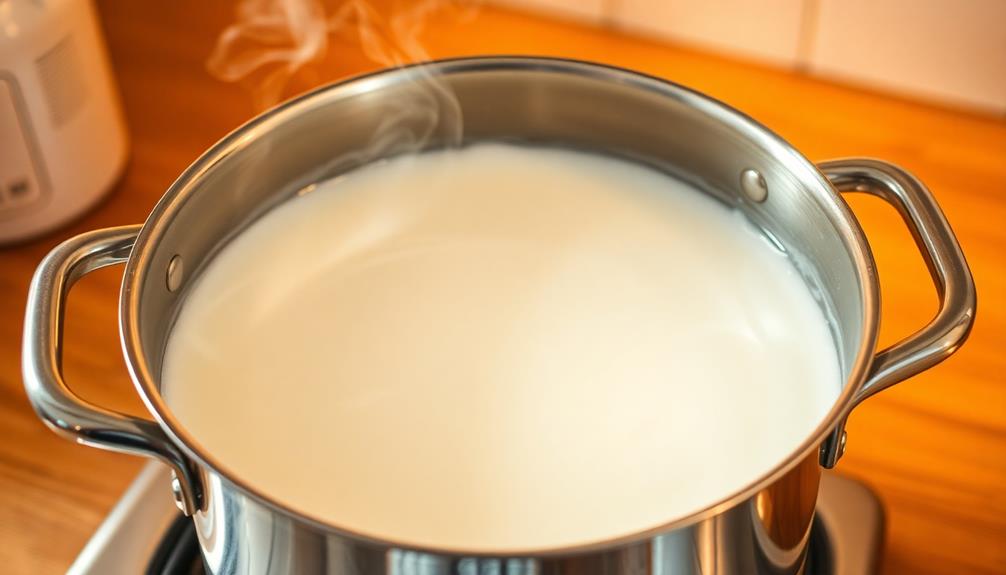
Boiling the milk until it curdles is the next crucial step in crafting the traditional fresh cheese, Ayib. Begin by pouring the fresh, whole milk into a large pot. Place the pot over medium-high heat and bring the milk to a gentle boil, stirring occasionally to prevent scorching.
As you prepare the milk, consider that certain health benefits of coffee can enhance your overall cooking experience, particularly when it comes to mood enhancement and cognitive function.
As the milk heats, you'll notice small curds starting to form and separate from the whey. This is the sign that the milk has reached the perfect temperature for curdling. Once the curds have fully formed, remove the pot from the heat. Gently stir the mixture to encourage the curds to continue separating from the whey.
Using a cheesecloth-lined colander, carefully strain the curds from the whey. Be sure to reserve the whey, as it can be used for other recipes.
Gently transfer the fresh curds to a mold or container, shaping them as desired. The curds are now ready to be pressed, salted, and enjoyed as the delicious Ayib cheese.
Step 2. Strain the Curds
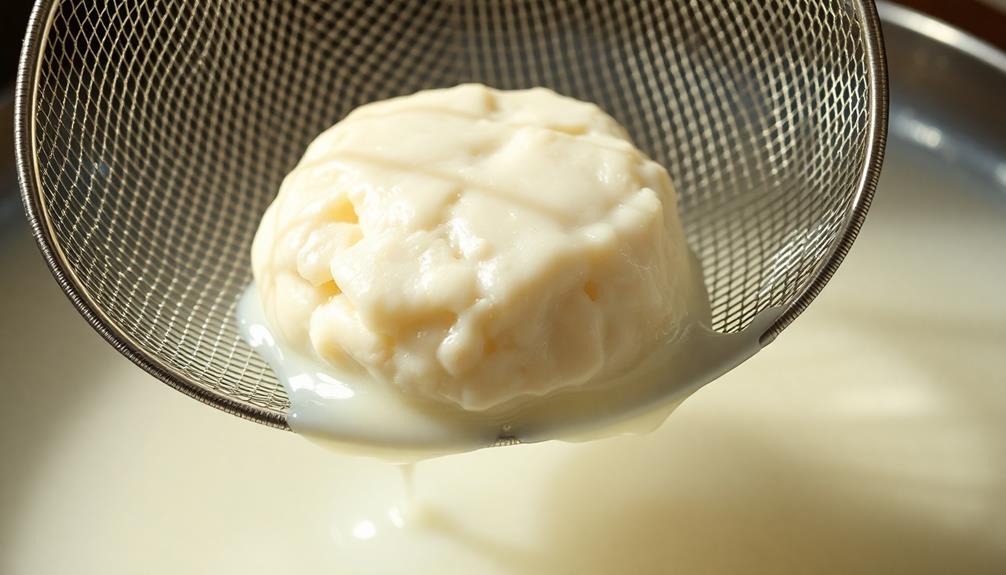
Once the milk has fully curdled, it's time to separate the curds from the whey.
Grab a large strainer or cheesecloth and place it over a bowl. Carefully pour the curdled milk into the strainer, allowing the liquid whey to drain into the bowl below. Gently stir the curds with a wooden spoon to help the whey escape.
Next, transfer the drained curds to a clean work surface. Use your hands to gently press and shape the curds into a smooth, even ball. This helps remove any remaining whey and gives the ayib its signature texture.
Once the ball is formed, you can place it in a mold or simply leave it as is.
Step 3. Squeeze Excess Whey From Curds

After transferring the drained curds to a clean work surface, gently press and shape the curds with your hands.
You'll want to remove as much excess whey as possible, so don't be afraid to apply a bit of pressure. Squeeze the curds, allowing the whey to drip off the sides onto the work surface. Once the curds have a firmer, more cohesive texture, gather them into a ball shape.
Next, wrap the ball of curds in a clean, slightly damp cheesecloth or kitchen towel.
Gently twist and squeeze the cloth, continuing to expel any remaining whey. This step is crucial in achieving the desired texture for your fresh ayib cheese.
Once the curds are relatively dry, you can unwrap them and transfer the cheese to a storage container or mold, if desired.
Remember to refrigerate the ayib until ready to use, as the fresh cheese has a short shelf life compared to aged varieties.
Step 4. Add Salt and Spices
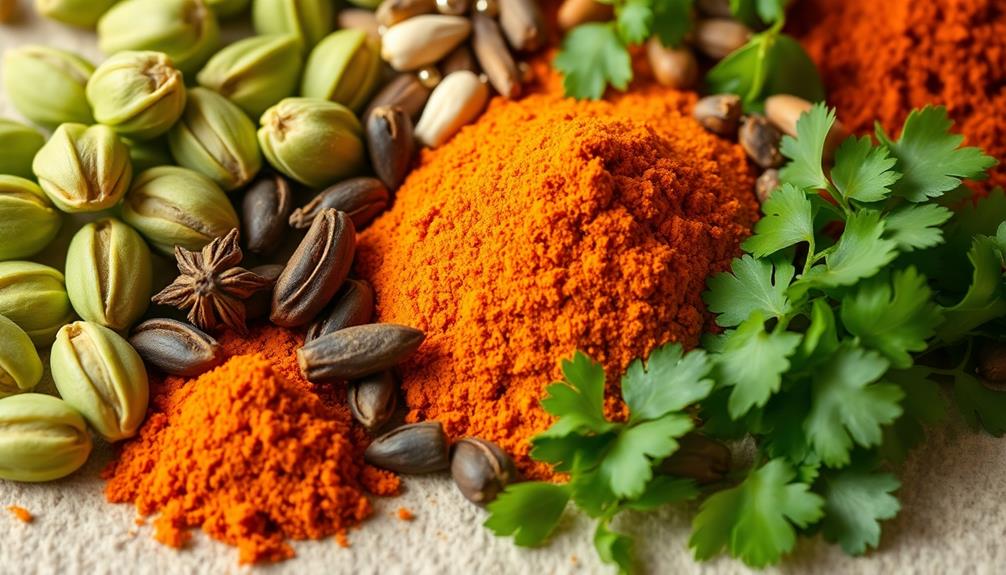
With the curds now well-drained, you can begin seasoning the ayib to your liking. Add a pinch or two of salt to enhance the cheese's flavor. Kosher salt works great, but you can use any salt you have on hand. Stir the salt into the curds until it's evenly distributed.
Next, consider adding some spices to give your ayib a unique twist. Ground cumin, paprika, or even a dash of cayenne pepper can add warmth and depth. Experiment with different combinations to find your perfect blend. Remember, a little spice goes a long way, so start with small amounts and taste as you go.
Once you've added the salt and spices, give the curds a gentle mix to incorporate everything. The goal is to create a flavorful, seasoned ayib that tantalizes your taste buds.
With your personalized seasoning, your homemade ayib is now ready to enjoy!
Step 5. Mold Into Desired Shape
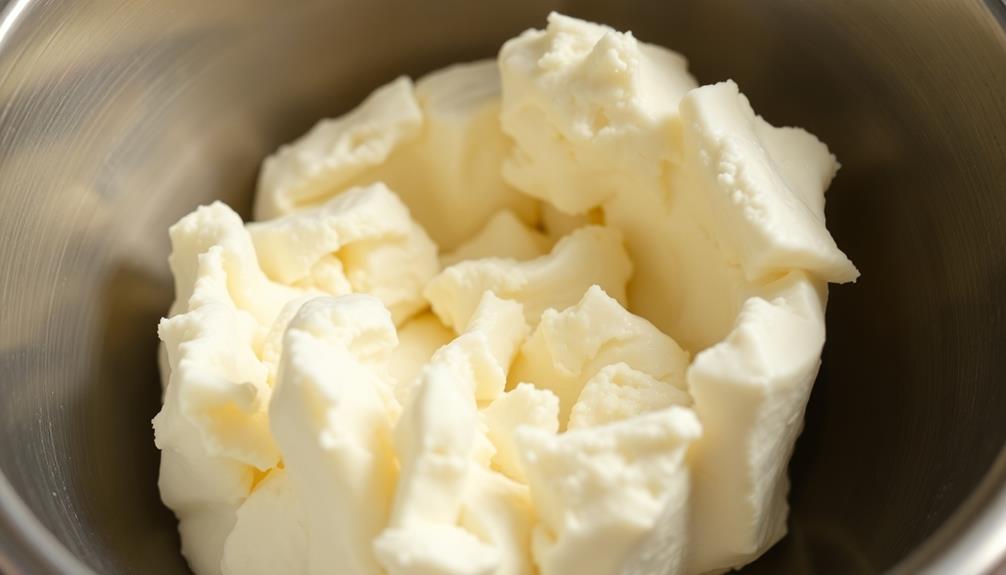
With the seasoned curds ready, you can now mold the ayib into your desired shape. Grab a small handful of the mixture and gently shape it into a round or oval form, using your palms to smooth the surface.
You can also press the cheese into molds to create intricate designs or uniform pieces. Be careful not to overwork the curds, as this can make the texture too dense.
Once molded, place the ayib on a clean surface, such as a plate or baking sheet. If you prefer a firmer texture, you can refrigerate the shaped cheese for 30 minutes to an hour before serving. This will help it hold its form better.
For a softer, creamier ayib, you can serve it immediately after shaping. Garnish with additional herbs, spices, or a drizzle of honey, if desired. Enjoy your homemade ayib in all its fresh, flavorful glory!
Final Thoughts
Ayib, the fresh cheese, is a versatile and delightful addition to any culinary adventure. Whether you're serving it as a snack, incorporating it into a savory dish, or using it to add a creamy texture to your favorite desserts, this cheese is sure to impress.
The process of molding ayib into desired shapes allows you to get creative and personalize your presentation, making it a wonderful choice for entertaining or simply elevating your everyday meals.
As you explore the world of ayib, remember to experiment and have fun. Don't be afraid to try new flavor combinations or presentation styles.
The beauty of this fresh cheese lies in its adaptability, so feel free to let your imagination run wild. With a little practice, you'll become a true ayib aficionado, impressing friends and family with your culinary skills.
Frequently Asked Questions
How Long Can Ayib Be Stored For?
You can typically store it for 3-5 days in the refrigerator. The shelf life depends on factors like storage conditions, but it's best to consume it within a week for optimal freshness and flavor.
Is Ayib Suitable for People With Lactose Intolerance?
Since you have lactose intolerance, you'll be happy to know that fresh cheese can be a suitable option. The aging process helps break down lactose, making it more digestible for those with lactose sensitivity.
Can Ayib Be Used in Baking or Cooking?
Yes, you can use ayib in baking and cooking. It's a versatile ingredient that can add creaminess and richness to dishes. Just be mindful of any dietary restrictions, as ayib is a dairy product.
What Is the Nutritional Value of Ayib?
The nutritional value of this food item can vary, but it often provides a good source of protein, calcium, and other essential nutrients. You'll want to check the specific nutritional information to understand its full benefits.
Where Can I Purchase Ayib in My Area?
To find ayib in your area, you can check with local Middle Eastern or African grocery stores, specialty cheese shops, or even some mainstream supermarkets that have a diverse selection of ethnic foods. You can also search online for local producers or distributors.
